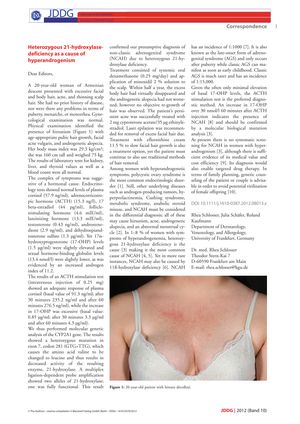Heterozygous 21-Hydroxylase Deficiency as a Cause of Hyperandrogenism
August 2012
in “
Journal der Deutschen Dermatologischen Gesellschaft
”
hyperandrogenism hirsutism acne vulgaris androgenetic alopecia 17-hydroxyprogesterone sexual hormone-binding globulin ACTH stimulation test CYP2A1 gene non-classic adrenogenital syndrome 21-hydroxylase deficiency dexamethasone minoxidil cyproterone acetate ethinylestradiol polycystic ovary syndrome androgenic alopecia 17-OHP SHBG NCAH Propecia Rogaine Diane-35

TLDR A woman's hyperandrogenism was caused by a genetic mutation leading to non-classic adrenogenital syndrome.
A 20-year-old Armenian woman presented with symptoms of hyperandrogenism, including excessive facial and body hair, acne, and thinning scalp hair, without a prior history of disease or menstrual problems. Physical examination confirmed hirsutism, acne vulgaris, and androgenetic alopecia. Laboratory tests revealed slightly elevated 17-hydroxyprogesterone (17-OHP) levels and a decreased sexual hormone-binding globulin level, suggesting a hormonal cause. An ACTH stimulation test showed an excessive increase in 17-OHP, leading to molecular genetic analysis which identified a heterozygous mutation in the CYP2A1 gene, confirming a diagnosis of non-classic adrenogenital syndrome (NCAH) due to heterozygous 21-hydroxylase deficiency. Treatment with dexamethasone and minoxidil resulted in the disappearance of excess body hair and stabilization of androgenetic alopecia, while acne was treated with cyproterone acetate/ethinylestradiol. The paper emphasizes that while polycystic ovary syndrome is the most common cause of hyperandrogenism, other conditions like NCAH should be considered, which is confirmed by an ACTH stimulation test and molecular genetic analysis. The incidence of NCAH is 1:1000, and it is important for targeted drug therapy and genetic counseling in family planning.
